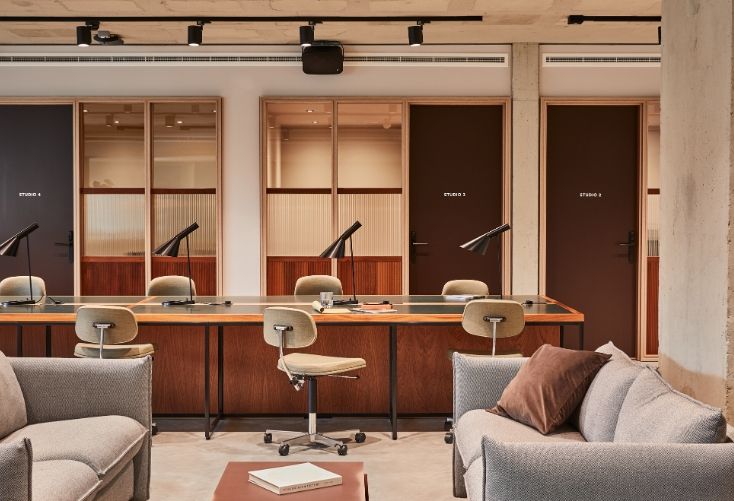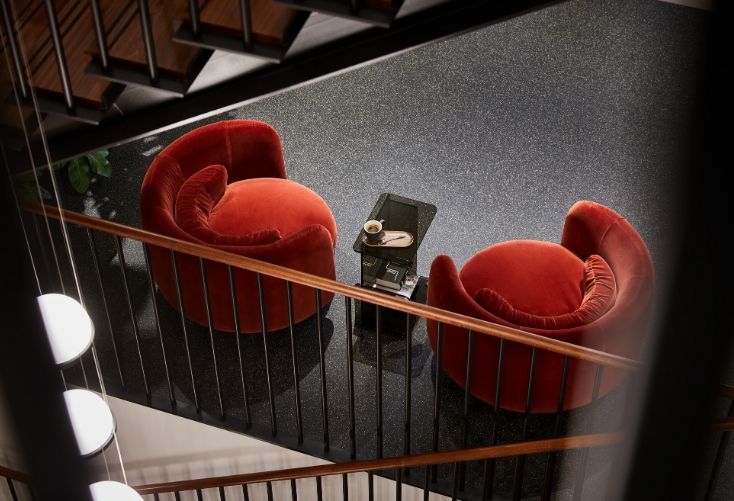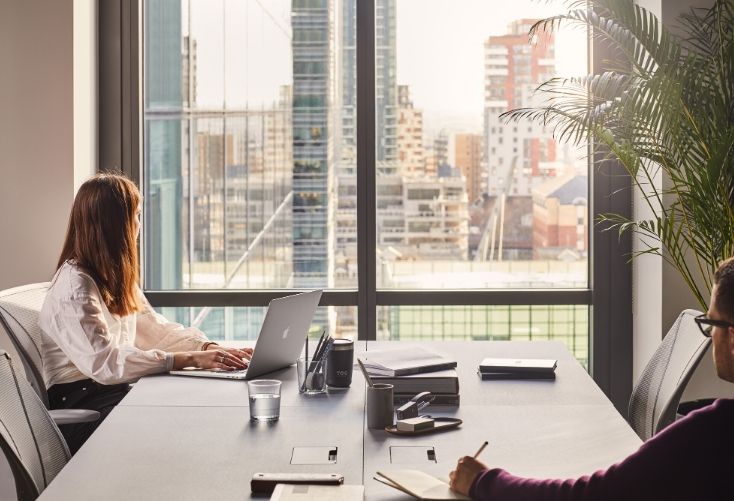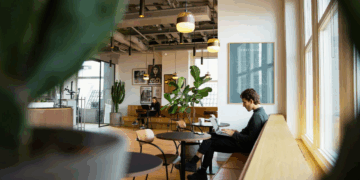- Now that many flexible spaces are finally able to welcome clients and members back to the office with certain safety measures in place, most are already thinking about the next stage of their journey through the pandemic.
- One-way systems, partitioned desks, upgraded air filtration systems and yes, sanitation stations, will continue to be the ‘new norm’ in the workplace.
- The Office Group’s Head of Design, Nasim Köerting talks to Allwork.Space about how operators can integrate these practical safety measures with a space that looks and feels beautiful, rather than clinical.
Tired of reading about hand sanitiser and physical distancing in the office? You’re not alone.
Unfortunately it’s going to remain part of daily life for the immediate future. But what comes after that? What happens when workspaces can finally throw out the physical distancing signs, and start moving forward to some kind of normal?
Now that many flexible spaces are finally able to welcome clients and members back to the office with certain safety measures in place, most are already thinking about the next stage of their journey through the pandemic.
Commenting for Dezeen, Helen Berresford, head of Sheppard Robson’s interiors studio, believes spaces will become more flexible in the sense that they can be open, closed, or rearranged to support specific activities. Above all, they must “flex” to keep pace with the changing world outside.
Long-term, there will likely be “accelerated evolution” in workspace design trends that we were seeing pre-pandemic, such as a continued convergence with the hospitality sector, and greater choice of how and where we work.
Flexible Workspace Design – What Comes Next
What could an accelerated evolution of workspace design look like?
The Office Group’s newly appointed Head of Design, Nasim Köerting, has some thoughts.
“It’s of paramount importance that we place people’s wellbeing at the heart of our design philosophy, in both current and future buildings,” said Köerting.

Even after the pandemic, it is likely that a lack of confidence in crowded spaces will remain. Therefore, Köerting suggests that one-way systems, partitioned desks, upgraded air filtration systems and yes, sanitation stations, will continue to be the ‘new norm’ in the workplace.
“Though people will still want to work in an aesthetically pleasing space when they return to work, practical office design is evidently more important than ever before, as it becomes inextricably linked with people’s health in a post-COVID society.”
TOG has implemented various measures for reopening, including floor markers, new furniture layouts, dedicated desks, and larger meeting rooms to enable physical distancing.
Now, Köerting’s focus is on integrating these practical safety measures with a space that looks and feels beautiful, rather than clinical.
“The art of blending style with substance has always been key to great office design. Workspaces should allow the businesses that occupy them to thrive — being both aesthetically pleasing and functionally seamless; designed to encourage positivity, wellness and productivity.”

The Smallest Details Make the Biggest Impact
Core to the concept of creating a workspace with wellbeing in mind is human comfort, and that starts with the most fundamental of office details: your chair.
Tens of thousands of workers were sent to work from home with just a few hours’ warning. TOG’s own research found that 92% of members said that their office chair is important for work, but only 55% are satisfied with the one they have at home.
The office provides an equal playing field, giving all occupiers the same space, the same furniture, and the same equipment. For Köerting, “Great design should be accessible to everyone — and now, more than ever, the industry should take note of this, and work to bridge that gap to create an exceptional office environment for all.”
The experience of lockdown, in which “ergonomic chairs were replaced by sofas and dining chairs, and natural light became confined to small windows”, prompted Köerting to rethink the finer details elements of the workplace.
“Although it might seem palpable that workers care about the chair they sit on for eight hours or more a day, I question whether offices have historically prioritised this feature for employees above say, a state-of-the-art coffee machine or an eye-catching feature wall.
“Sometimes, it really is the smaller details that make the biggest difference to our daily lives; the office chair must be a key design focus, not an afterthought. In fact, we consider the chair to be so fundamental that we are in the process of designing our own task chair which keeps to our design credentials as well as offering ergonomic support.”
Renewed Focus on Collaboration Space
Köerting’s own experiences of lockdown, particularly the challenges of trying to have creative sessions over a video call, reminded her of how important it is to have access to a workspace for team catch ups, group brainstorms and the more social aspects of work life.
Adding to this, TOG’s survey found that 56% of their members feel disconnected from their colleagues — highlighting that even though there have been successes to enforced working from home, there is no doubt that there is still a place for the physical office after the pandemic.
Furthermore, there are many important design lessons we can learn from the more enjoyable moments of working from home, such as having one place with multiple areas for different types of working.
“There were benefits to working from home, so it should be our mission to translate these into the workspaces of the future, whilst retaining what makes this environment unique in its ability to enhance productivity and wellbeing where possible.”

This could be creating separate zones for different purposes, such as spaces for quiet working, shared thinking, and down time. Köerting notes that this has “always been central to the TOG design ethos, but this period has further convinced me that it’s a crucial consideration for any office provider.”
The health crisis has triggered a rethink within the world of design and workplace experience. While the journey to this realisation has been devastating, the future outcome offers positivity in the sense that there is now a renewed and urgent emphasis on creating spaces that nurture our personal health and wellbeing.
“I still believe that great design involves unifying style and substance,” added Köerting. “But in this new era, designers and architects must realise that the goalposts have shifted. With health and wellbeing at the forefront of everyone’s minds, it is also now intertwined with creating a safe, hygienic environment for occupants.”


 Dr. Gleb Tsipursky – The Office Whisperer
Dr. Gleb Tsipursky – The Office Whisperer Nirit Cohen – WorkFutures
Nirit Cohen – WorkFutures Angela Howard – Culture Expert
Angela Howard – Culture Expert Drew Jones – Design & Innovation
Drew Jones – Design & Innovation Jonathan Price – CRE & Flex Expert
Jonathan Price – CRE & Flex Expert















